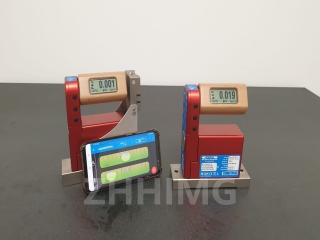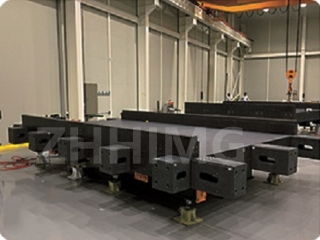In cutting-edge fields such as semiconductor chip manufacturing and precision optical inspection, high-precision sensors are the core devices for obtaining key data. However, complex electromagnetic environments and unstable physical conditions often lead to inaccurate measurement data. The granite base, with its non-magnetic, shielded properties and excellent physical stability, builds a reliable measurement environment for the sensor.

The non-magnetic nature cuts off the source of interference
High-precision sensors such as inductive displacement sensors and magnetic scale scales are extremely sensitive to changes in the magnetic field. The inherent magnetism of traditional metal bases (such as steel and aluminum alloy) can create an interfering magnetic field around the sensor. When the sensor is in operation, the external interference magnetic field interacts with the internal magnetic field, which can easily cause measurement data deviations.
Granite, as a natural igneous rock, is composed of minerals such as quartz, feldspar and mica. Its internal structure determines that it has no magnetism at all. Install the sensor on the granite base to eliminate the magnetic interference of the base from the root. In precision instruments such as electron microscopes and nuclear magnetic resonance, the granite base ensures that the sensor accurately captures the subtle changes of the target object, avoiding measurement errors caused by magnetic interference.
Structural characteristics are coordinated with electromagnetic shielding
Although granite does not have the conductive shielding ability like metals, its unique physical structure can also weaken electromagnetic interference. Granite is hard in texture and dense in structure. The interlaced arrangement of mineral crystals forms a physical barrier. When the external electromagnetic waves propagate to the base, part of the energy is absorbed by the crystal and converted into heat energy, and part is reflected and scattered on the crystal surface, thereby reducing the intensity of the electromagnetic waves reaching the sensor.
In practical applications, granite bases are often combined with metal shielding nets to form composite structures. The metal mesh blocks high-frequency electromagnetic waves, and the granite further weakens the residual interference while providing stable support. In industrial workshops filled with frequency converters and motors, this combination enables sensors to operate stably even in a strong electromagnetic environment.
Stabilize physical properties and enhance measurement reliability
The coefficient of thermal expansion of granite is extremely low (only (4-8) ×10⁻⁶/℃), and its size changes very little when the temperature fluctuates, ensuring the stability of the sensor installation position. Its excellent damping performance can quickly absorb environmental vibrations and reduce the influence of mechanical disturbances on measurements. In precision optical measurement, the granite base can prevent optical path offset caused by thermal deformation and vibration, ensuring the accuracy and repeatability of measurement data.
In the scenario of semiconductor wafer thickness detection, after a certain enterprise adopted the granite base, the measurement error decreased from ±5μm to within ±1μm. In the form and position tolerance inspection of aerospace components, the measurement system using a granite base has improved data repeatability by more than 30%. These cases fully demonstrate that the granite base significantly enhances the measurement reliability of high-precision sensors by eliminating electromagnetic interference and stabilizing the physical environment, making it an indispensable key component in the modern precision measurement field.
Post time: May-20-2025

